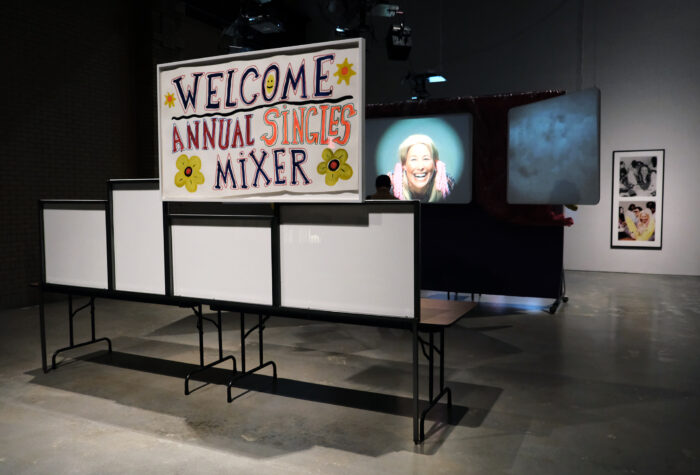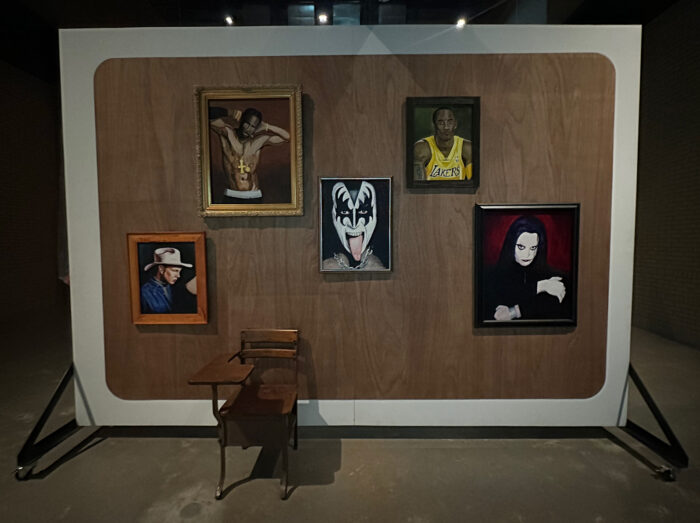
Mike Kelley reimagined scenes from high school yearbooks in 2005, more than 30 years after his own graduation but before American teens fully embarked on their ceaseless march toward virtual socialization. If the films that make up Kelley’s collection Day is Done are any indication, high school culture hasn’t changed much. If anything, the soul-crushing social stratification and ritualistic adherence to meaningless, made-up norms have only gotten worse over the decades.
“With the proliferation of social media platforms, Kelley’s satire on human interaction remains as relevant today as when he first imagined Day Is Done in the early 2000s,” said mega-collector Peter M. Brant. Singles Mixer, one of the 31 Kelley video “reconstructions” of high school happenings that make up Day is Done, opened Friday in the lower Manhattan outpost of the Brant Foundation.

Singles Mixer is a terrifying three-channel video drama in which five girls discuss their dream men. In doing so, they reveal themselves as small-minded American adolescents, siloed in their diversity, antagonistic toward the ideas and beliefs of others, and set stubbornly in their pathetic dedication to celebrity icons. As has forever been the case in America’s real-life high schools, the girls’ silos are constructed around stereotypes about race, class, and gender. The characters are guilty of stereotyping and of being stereotyped at the same time.
However, the work transcends any message about high school, adolescent crushes, or teenage angst to examine the depth of self-absorption across social strata and its dangerous implications. When violence erupts among the girls in Singles Mixer, it is hardly just anger-tainment. Kelley, in a 2005 interview with nonprofit documentary-maker Art21, explained that Singles Mixer and the rest of the Day is Done films are intentionally traumatic and ridiculous to neutralize the idea that trauma and suffering are essential components of modern life.
“The basic premise is that it’s all based on trauma culture, and that’s a contemporary motivation, like a basic motivational idea. And I have to undermine that. I think having something be somewhat ridiculous is a way of undermining that notion—that life is just about trauma. This is also something that is very much embedded in a lot of modernist work—expressionism and existentialist artworks—that kind of heavy artist-as-sufferer . . . I have no interest in that,” he said.

While all of the film’s action takes place face-to-face in a classroom setting, it’s easy to envision the same scenario taking place today with the girls siloed not just by their shallow ideas and self-absorption, but also physically separated by the isolation of social media. The interaction could easily take place today in a virtual setting where separation can allow cruelty to soar, while at the same time shielding the participants from the threat of immediate physical backlash.
In Singles Mixer, there’s the freckle-faced hillbilly with blond hair in pigtails, the Kiss fan in full face paint, the goth in black-and-white make-up and witch’s garb, and four African American women. Their dream dates? The hillbilly likes Garth Brooks; the Kiss fan, Gene Simmons; the witches, Brandon Lee from The Crow; and the black women, R. Kelly and Kobe Bryant.
The women dreamily describe their preferred male icons, haughtily dismissing the taste of the others, until the situation devolves into a physical clash between the hillbilly and the Kiss fan, the two tumbling about on the floor and choking each other. When a combatant gains the advantage, she goes tellingly for the throat, emphasizing the deadly seriousness of her devotion to false icons, like gang members defending their turf or nations at war.
There’s one male in the drama, apparently tossed in to represent stereotypes around male shallowness, sexism, and stupidity. In his Jake-from-State-Farm outfit and shades, the guy, who was described by Kelley as a computer nerd, seems a contented observer. He notes that he likes Bryant because the late hoops superstar had his choice of women, and he smiles luridly when the women fight.

Kelley draws all this from a single black-and-white yearbook photograph, which is included in the installation along with original Kelley portraits of the dream men. “All of these videos are based on high school yearbooks. It’s not because I have any interest in high school, or high school culture, but it’s one of the few places you can find photographs of these kinds of rituals,” he said in the Art21 interview.
“How each person sees it is specific, if that makes sense, and what you take away from it is very subjective,” Allison Brant, the foundation’s director, said in an interview. She added that viewers’ interpretations of the work are sort of second-generation ideas since the film is itself an interpretation by Kelley of something he saw in a high school yearbook.
“A lot of different things are addressed and maybe you identify more with one characterization or one envisionment of a ritual because he’s taking source material (yearbook photographs) and creating an entire story around them. That’s really what each segment is about,” she said.
Even in 2005, seven years before his suicide, Kelley was rebelling against the mainstream conditioning of people in a postmodern world dominated by ephemeral pop culture, entitlement, and intolerance that spawns decadence, alienation, and violence. As the world has evolved since the creation of Singles Mixer and Day is Done, that kind of multi-polarization has only worsened, as Kelley presaged nearly 20 years ago.
“My interest in popular forms was not to glorify them—because I really dislike popular culture in most cases. I think it’s garbage, but that’s the culture I live in, and that’s the culture people speak,” Kelley said.
“I’m an avant-gardist. We’re living in the postmodern age, the death of the avant-garde. So, all I can really do now is work with this dominant culture and flay it, rip it apart, reconfigure it, expose it— because popular culture is really invisible. People are really visually illiterate,” he added.
